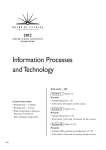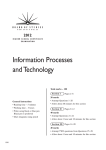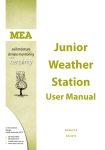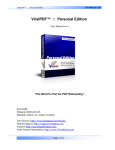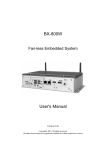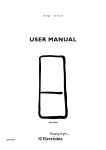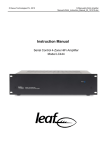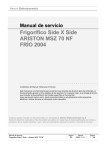Download Manual PDF
Transcript
© Nexus Technology P/L, 2010 S:\Manuals\SAM\SAM_Instruction_Manual_01_141010.doc Instruction Manual Nexus Technologies Defined Area Early Warning System Remote Console Model SAM © Nexus Technology P/L, 2010 Client: Status: Authorised by: Comment Closure Date: Version 1 2 3 4 Date 181010 S:\Manuals\SAM\SAM_Instruction_Manual_01_141010.doc Document Status Nexus Controlled external release DJA 181010 Revision History Changes Initial Release © Nexus Technology P/L, 2010 S:\Manuals\SAM\SAM_Instruction_Manual_01_141010.doc Table of Contents 1 INTRODUCING THE SAM........................................................................... 4 1.1 Brief Overview ................................................................................................................. 4 1.2 The Key Concepts ........................................................................................................... 5 1.2.1 Updating your cell ...................................................................................................... 5 1.2.2 The information displayed.......................................................................................... 5 1.2.3 Installation.................................................................................................................. 6 1.2.4 Maintenance .............................................................................................................. 6 1.2.5 SAM Front Panel ....................................................................................................... 7 1.2.6 SAM External Connections ........................................................................................ 7 2 INSTALLATION GUIDE .............................................................................. 8 3 USING THE SAM ........................................................................................ 8 3.1 3.2 3.3 3.4 3.5 User Mode ........................................................................................................................ 8 Installer Mode .................................................................................................................. 9 Configuration Mode ...................................................................................................... 11 Storage of Settings........................................................................................................ 12 Loss of Signal ................................................................................................................ 12 APPENDIX A: RDS .......................................................................................... 13 APPENDIX B: EXTERNAL SIGNALS ............................................................. 14 APPENDIX C: SPECIFICATIONS ................................................................... 15 SAM User Manual Page 3 Of 15 © Nexus Technology P/L, 2010 S:\Manuals\SAM\SAM_Instruction_Manual_01_141010.doc 1 Introducing the SAM It is important that the user read and understand this section so that they are aware of what the system can and cannot do for them. In times of emergency the DAEW can provide them with critical information about an impending threat, but what actions they should take in such circumstances are their choice entirely. The user must have a prepared plan of action – whether to stay and defend or evacuate in a safe and timely manner. The DAEW must also not be considered to be one hundred percent reliable. No system can ever be. The user must understand that the DAEW information, like any other source of information, can be obsolete, inaccurate or at worst, incorrect. The DAEW is simply another method of keeping the user informed and should only be used to supplement not replace existing Internet, free-to-air or subscription media, telephone, SMS, audible warning system or other form of alert messaging. 1.1 Brief Overview The Defined Area Early Warning (DAEW) system is aimed at assisting people living in bushfire prone areas to better protect themselves and make informed and timely decisions about evacuating or staying with property in the event of fire. The DAEW system has been designed to provide a means of delivering a geographically specific threat warning to individuals or groups within high risk areas. Delivery areas are defined as cells on an arbitrary grid which may be as small as one kilometre. The system also caters for delivering the same message to an area as big as a Total Fire Ban district or even the entire state. This enables total fire ban information or district-wide fire danger ratings to be efficiently broadcast. The DAEW has been designed primarily as a fire warning system, but there is no reason why the system cannot be used for other geographically-specific threats such as flood or tsunami. Messages consisting of a cell number and threat message codes are electronically sent to existing free-to-air FM radio stations for transmission. The system uses the FM Radio Data Service (RDS) to deliver the threat message information. These transmissions do not interfere with normal audio content. The specially designed radio receiver (codenamed SAM) is used to decode and display the messages. SAM is a prototype radio receiver with a 24 hour battery backup, a text display, visual threat display and an audio alert. SAM is also able to control external devices such as sprinkler systems or rotate automated Fire Danger Rating Signs and is able to be solar powered. The latest threat message for the receiver‟s cell remains on display, meaning that the user need only check the radio when able or convenient instead of having to listen at specific times. It is important to note that SAM is only a prototype. It has been produced to demonstrate the core concepts of the DAEW system. It may be obvious that large amounts of money have not been spent on making it as sleek and stylish as an iPhone, indeed R&D has been solely devoted to making a robust and simple product SAM User Manual Page 4 Of 15 © Nexus Technology P/L, 2010 S:\Manuals\SAM\SAM_Instruction_Manual_01_141010.doc that fulfils the needs that drove the design requirements in the first place. There is much more that could be done within the existing design scope with just software changes and it is this functionality that is under examination in this trial. There are several menu items that have no meaning, do not function or make no difference in operation. These are „stubs‟ of functions that are either redundant, still under development or have yet to be implemented. Please approach any aberrant operation of these items with a little bit of patience and understanding. 1.2 The Key Concepts 1.2.1 Updating your cell The DAEW transmits threat information to all cells in the coverage area all the time. As the information is broadcast by a free-to-air FM station, there is no limit on the number of receivers and no possibility of extra traffic overloading the system in emergency. All that is required is that the SAM receiver has good signal strength from the transmitter site. The SAM listens to all the DAEW messages transmitted, but only displays the threat codes for the cell it is programmed for. The amount of information that the RDS subsystem can transmit is not without bounds. There is not a lot of „bandwidth‟ available, so the DAEW information is quite succinct to keep update times or latency as low as possible. Realistically, it can take a couple of minutes to update all cells covered by a particular FM radio station if all cells are at the same threat level. Such a case isn‟t a problem when the threat level is the normal, non-critical one, but becomes more important when the threat is not trivial. Currently all cells are given equal priority, but in future, a system with dynamic priority allocation would update cells at higher threat levels more frequently than those at lower levels. At installation time the SAM will be assigned a cell identification code and this is stored in permanent memory. The SAM must remain in the cell it has been programmed for or else the information it delivers may not be accurate. Moving the SAM or changing its cell identification could render the device useless or worse to give information that is not accurate for where the receiver is physically located. The final consideration is that the DAEW can only deliver the information that is fed to it. If this information is inaccurate or stale then the DAEW cannot improve it. 1.2.2 The information displayed The SAM delivers the threat information for the cell it resides in the following ways In plain text on the LCD display On the colour-coded LED threat „tree‟ As audible tones from the loudspeaker Via optional external threat display and or siren The nomenclature and colours are harmonised with the current Fire Danger Rating (FDR) as reproduced in the following table. SAM User Manual Page 5 Of 15 © Nexus Technology P/L, 2010 S:\Manuals\SAM\SAM_Instruction_Manual_01_141010.doc There is also a separate Total Fire Ban Indicator down the bottom of the SAM front panel. Currently this will light whenever the threat is above the Low-Moderate level, but in future it is envisaged that this will be enabled by a unique signal delivered by the DAEW and may give advance warning of a TFB day to follow, at a time when the threat level may still be low. Fire Danger Rating Flame Ht/Rate Category Fire of Danger Index Spread Catastrophic 100+ Extreme 75-99 Severe 50-74 Very High 25-49 Variable High 12-24 Low0-11 moderate <2 Hrs Time to Impact 2-6Hrs 6-24Hrs Emergency Warning + SEWS 24+Hrs Watch and Act Advice 1.2.3 Installation 1.2.3.1 Signal The SAM receiver must be installed where it has a totally reliable and strong signal from the FM broadcaster carrying the DAEW service. The SAM comes with a 70cm whip antenna mounted directly to the case. This is suitable only for protected or inside use. If an external antenna is required or greater gain needed then an external directional FM or TV antenna may be needed. 1.2.3.2 Location The SAM receiver is not weather proof. It must be located under cover of direct weather. It must also be located where there is access to permanent and reliable electricity supply. This can either be a mains power socket or DC feed from a solar installation. The SAM must be placed where it can attract attention. Out of sight, out of mind with this device is pointless. Place it where you are going to be able to see and hear it. If you need another one for the outhouse, back shed or second story, then either use the external siren and display facilities or consider purchasing supplementary unit(s). 1.2.4 Maintenance The SAM has a 12V Sealed Lead-Acid battery, capable of providing at least 24 hours backup time under low-moderate threat conditions. This battery must be tested and renewed if necessary at least twice a year. There is some limited scope for the system to launch a battery self-test to the SAM, but at this time this functionality has not been implemented. SAM User Manual Page 6 Of 15 © Nexus Technology P/L, 2010 S:\Manuals\SAM\SAM_Instruction_Manual_01_141010.doc 1.2.5 SAM Front Panel Once installed, SAM needs no further attention other than when there is a change in the fire threat level to the cell that it is installed in. It is however, of the utmost importance to know what exactly is the information that SAM provides, and how it is shown. Plain Text Status Display Control Knob Threat Status Lamps LoudSpeaker Lamps Total Fire Ban Status Lamp Although the Threat Status LED Lamps are clear when not lit, they do light up in the appropriate FDR colours. The lamps also flash to attract attention. A Catastrophic FDR is signified by the upper two lamps (Amber and Red) flashing alternately. The loudspeaker will be turned on when the threat level is above Low-Moderate so that any accompanying voice announcements from the FM radio station broadcasting the DAEW signal can be heard. 1.2.6 SAM External Connections The SAM provides connections for antenna, power, serial data, external siren and display and analog audio output. All connectors are at the base of the unit. The following picture shows the layout of the connectors: SAM User Manual Page 7 Of 15 © Nexus Technology P/L, 2010 S:\Manuals\SAM\SAM_Instruction_Manual_01_141010.doc External Status Lamp Connections Power Input External Relay Connections Mono Audio Output External LoudSpeaker or Siren RS232 Serial Data 2 Installation Guide For the installer familiar with the basic operation of the SAM menu system, the following steps are required to configure the unit for use: Remove 8 countersunk M3 screws top and bottom and remove the rear section of the case. Connect the battery flying lead to the connector on the back of the PCB paying attention that the correct polarity has been observed. Set the volume and tone signalling internal dipswitch options as requested by the user. Refit the rear case section and secure it with the screws removed earlier. Connect the plug pack to the mains supply, plug the DC lead into the SAM and the antenna lead to the antenna socket. Connect serial, external relay, external lamp and external siren as required. Set the cell identification code to the assigned cell number. Set the tuner to the frequency of the station broadcasting the DAEW information and store this to preset 1. Set FM channel volume to the level requested by the user. Verify that the SAM is decoding the DAEW signal and the threat status is flashing green and the LCD is displaying Low-Moderate. The SAM is now ready for use. 3 Using the SAM 3.1 User Mode The SAM has no real use for the end user except when an emergency exists. The user can check that the SAM is operational by pressing the control knob in, which will turn on the audio amplifier and send the received audio signal to the internal (and external if fitted) loudspeaker. Future user-accessible enhancements will include: SAM User Manual Page 8 Of 15 © Nexus Technology P/L, 2010 S:\Manuals\SAM\SAM_Instruction_Manual_01_141010.doc Extensive self-test diagnostic routines that will allow the user to verify that the SAM is operating as it should. The ability to monitor any other cell to determine the threat in that cell. The primary use of this function is to evaluate the best escape route in an emergency. 3.2 Installer Mode Installer mode is accessed from User Mode by pressing the selection knob 4 times within 1 Second. The display will show the message “Exit Installer Y” if this process has been performed correctly. Rotate the control knob ccw and press it to enter Installer Mode. In Installer and Configuration Modes, a 30 second inactivity timer is running and will result in operation being returned to User Mode if there is no front panel control actions within this time. Note that the SAM continues to receive and decode any DAEW messages whilst in this mode. Installer Mode features the following menu structure: Set Volume Select Frequency Select Preset Select Config Exit Installer Using the Installer Mode functions as described allows the installer to quickly set up the SAM at the user‟s premises; adjust the volume and set up the station presets. SAM User Manual Page 9 Of 15 © Nexus Technology P/L, 2010 S:\Manuals\SAM\SAM_Instruction_Manual_01_141010.doc Set Volume is used to adjust the receiver volume to a level suitable for the user. It should be set so that it demands attention in an emergency situation that may have a high background noise level. Select Frequency sets the operating frequency of the radio station carrying the DAEW signal. Rotate the control knob ccw to decrease the frequency or cw to increase the frequency. Press the control knob when the selection is complete. When a selection has been made by pressing the control knob, the next function in the tree (Select Preset) is made active. Note that the frequency step sizes and upper and lower frequency limits for FM are individually configurable as separate items in the Configuration Menu. Select Preset brings up a sub-menu that allows a preset to either be recalled for editing or to save the current configuration to. The Select Preset Menu structure is as follows: Preset Recall Preset Save Selecting the Preset Recall function allows any of the 20 saved presets for the SAM to be recalled, overwriting the current configuration when the control knob is pressed. Turning the control knob ccw will move the selection down towards preset 1, turning the control knob cw will move the selection up towards preset 20. The Preset Recall function may be aborted by rotating the control knob cw from preset 20 to access the exit option. In a similar fashion, selecting the Preset Save function allows the current configuration to be saved to any of the 20 presets when the control knob is pressed. Turning the control knob ccw will move the selection down towards preset 1, turning the control knob cw will move the selection up towards preset 20. The Preset Save function may be aborted by rotating the control knob cw from preset 20 to access the exit option. Exiting either of the above functions will result in control being passed back to the Set Volume function. A future enhancement will be to provide a PIN to lock out installer mode to nonqualified access. SAM User Manual Page 10 Of 15 © Nexus Technology P/L, 2010 S:\Manuals\SAM\SAM_Instruction_Manual_01_141010.doc 3.3 Configuration Mode The Configuration Mode is used to set up the more basic operational parameters of the receiver. The installer should only ever have to use the configuration functions once, usually at the initial setup stage. Configuration Mode features the following menu structure: Set Brightness (1 – 8) Audio Timer Set FMin AM ( Step AM kHz) Set Contrast (1 – 8) Set Step FM (1 – 10 x 10kHz) Set FMax AM (Step AM kHz) Set Mute Set Step AM (1 – 9 x 1kHz) Preset Scan (Y, N) Set Pri Zone Set FMin FM (Step FM MHz) Null 2 Set Sec Zone Set FMax FM (Step FM MHz) Exit Config? (Y, N) Of the available functions only Set Brightness, Set Contrast and Set Pri Zone should be used. Accessing any of the other functions may cause unpredictable results and possible erroneous operation of the SAM. Unless otherwise described, exiting one function will result in the next function down the tree being accessed. For example, once the Set Brightness function has been used to adjust the display brightness, exiting this function will result in the installer being prompted to access the Set Contrast function. Set Brightness allows the display brightness to be altered to suit the installation. Rotating the control knob ccw to a setting of 1 will result in the backlight being almost off, rotating the control knob cw to a setting of 8 will result in the backlight being driven to maximum brightness. Press the control knob to make the selection and return to the configuration menu. SAM User Manual Page 11 Of 15 © Nexus Technology P/L, 2010 S:\Manuals\SAM\SAM_Instruction_Manual_01_141010.doc Set Contrast is used to adjust the contrast of the display characters with respect to the background. This also has an effect on the viewing angle. Rotate the control knob ccw towards setting of 1 or cw towards a setting of 8 to achieve maximum contrast at the normal viewing angle. Press the control knob to make the selection and return to the configuration menu. Set Pri Zone is used to select the cell code that the SAM is zoned for. At this stage of development the range of cells is 0 through 15. Rotate the control knob ccw towards the minimum setting of 0 or cw towards a maximum setting of 15. Press the control knob to make the selection and return to the configuration menu. 3.4 Storage of Settings Non-volatile FLASH memory is used to store all operating parameters. This includes all items that are able to be setup in the Installer Menu as well as all items in the Configuration Menu. It is important to note however, that backup to permanent memory does not happen immediately after each and every change of any parameter, it only takes place after a period of 20 seconds of no activity after a change has taken place. Thus it is important not to power down the unit immediately after making changes to the SAM installer or configuration settings. 3.5 Loss of Signal Should the SAM not be able to decode a DAEW message with its cell code within a preset time period, it will show “No Cell Message” on the display. If the SAM experiences loss of valid DAEW signal when not at the Low-moderate level it will presume the worst and autonomously escalate the threat level with successively shorter intervals. [Ends] SAM User Manual Page 12 Of 15 © Nexus Technology P/L, 2010 S:\Manuals\SAM\SAM_Instruction_Manual_01_141010.doc Appendix A: RDS The SAM decodes the Group 9A codes of RDS Blocks C and D. This is the Emergency Warning System (EWS) allocation of the RDS standard. If you have a receiver capable of displaying RDS messages and it displays text other than the normal data transmitted by the station during the DAEW operation, please advise the station. SAM User Manual Page 13 Of 15 © Nexus Technology P/L, 2010 S:\Manuals\SAM\SAM_Instruction_Manual_01_141010.doc Appendix B: External Signals The SAM makes available some signals for external use. These signals are: RS232 raw RDS DAEW data for external processing Line level audio for smart home emergency annunciation Open-collector drive for an external threat display Speaker drive out for an external siren or speaker Uncommitted relay contacts for an emergency sprinkler system or other similar device. The specifications for each of these signals or signal groups is contained in the Specifications Appendix, but it is worth discussing the relay contact function a bit further here. There are two sets of relay contacts, separately energized. Both sets have the Common, Normally Open and Normally Closed contacts bought out to their respective connectors. Relay A is driven whenever the threat level is above the Low-Moderate level. Relay B is driven whenever the threat level is at the Catastrophic level. There is no prescribed or recommended implementation for these relays as the variety of end uses is virtually limitless. A future enhancement will be to provide customizable trigger thresholds for these functions. SAM User Manual Page 14 Of 15 © Nexus Technology P/L, 2010 S:\Manuals\SAM\SAM_Instruction_Manual_01_141010.doc Appendix C: Specifications Parameter Specification Control Text Display Text Display Controls Status Display Bidirectional Rotary Control, Push-to-Select 16 characters x 1 line LCD, backlit blue Adjustable Brightness and Contrast 6 x high-brightness LEDs Number of Presets Tuning Range (FM) Tuning Step Size (FM) 20 Programmable: 88.00 to 108.00 MHz default Programmable: 10 to 100kHz Antenna Input Audio Output RS232 Serial Data F-Type Socket Single (mono) RCA Socket DB9 Female, wired DCE Baud Rate Format Data format RS232 9600 Baud 8, N, 1 Binary Relay Contacts External Lamp Drive External Speaker Drive No/C/NC, 24V DC max, 1Amp max Open Collector, 12VDC max, 500mA max. 7W, 4Ω minimum Power Requirements Power Connector 10 to 35V dc, 1 Amp 2.1mm DC socket, centre positive Dimensions (W x D x H) Weight 210 x 210 x 70 2.35kG (without antenna) SAM User Manual Page 15 Of 15















